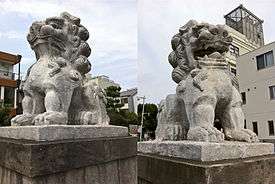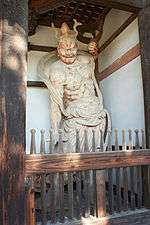A-un
The term A-un (阿吽) is the transliteration in Japanese of the two syllables "a" and "hūṃ", written in Devanagari as अहूँ.

The original Sanskrit term is composed of two letters, the first and the last (Anusvara) of the Sanskrit alphabet. Together, they symbolically represent the beginning and the end of all things.[1] In Japanese Mikkyō Buddhism, the letters represent the beginning and the end of the universe.[2] This appears in Greek as Alpha-Omega, similarly adopted by Christianity to symbolize Christ as the beginning and end of all.
The term is also used in Shinto and Buddhist architecture to describe the paired statues common in Japanese religious settings, most notably the Niō and the komainu.[1] In most cases one of the two, the right one, has its mouth open to pronounce the sound "a", while the other has it closed to utter the sound "um". The symbolism is the same already seen. The generic name for statues with an open mouth is agyō (阿形, lit. "a" shape), that for those with a closed mouth ungyō (吽形, lit. "un" shape").[1]
The term a-un is used figuratively in some Japanese expressions as "a-un breathing" (阿吽の呼吸, a-un no kokyū) or "a-un relationship" (阿吽の仲, a-un no naka), indicating an inherently harmonious relationship or non-verbal communication.
In India, the original Sanscrit "a-huṁ" or simply "Om" is used as a mantra for meditation.
Some a-un pairs
- An agyō komainu
- An ungyō komainu
 Agyō Niō at the Central Gate of Hōryū-ji
Agyō Niō at the Central Gate of Hōryū-ji Ungyō Niō at the Central Gate of Hōryū-ji
Ungyō Niō at the Central Gate of Hōryū-ji
Popular culture
"Om" by The Moody Blues (on In Search Of The Lost Chord, 1968), pronounced "a-ohm", is a meditation song describing the mystical concept of heaven linking all.
References
- Japanese Architecture and Art Net Users System (JAANUS), "A un" (阿吽), 2001, retrieved 2011-04-14.
- Daijirin Japanese dictionary, 2008, Monokakido Co., Ltd.
| Wikimedia Commons has media related to Aun. |